Widgetized Section
Go to Admin » Appearance » Widgets » and move Gabfire Widget: Social into that MastheadOverlay zone
Review: Ruger 9mm Pistol Caliber Carbine (PCC)
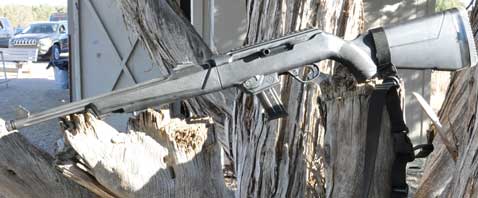 Assembling at Gunsite for a writer’s event, the dozen or so of us in attendance did our very best to shoot all the guns and free ammo offered. Day Two was devoted to the new Ruger Pistol Caliber Carbine (PCC) in 9mm and before the day was over we had fired many thousand rounds of Hornady Critical Defense and American Gunner ammunition through a dozen carbines with, as far as I could tell, one or two malfunctions. Considering we took the carbines out of the boxes and shot them without cleaning or lubricating this proves to me the little rifles are exceedingly reliable.
Assembling at Gunsite for a writer’s event, the dozen or so of us in attendance did our very best to shoot all the guns and free ammo offered. Day Two was devoted to the new Ruger Pistol Caliber Carbine (PCC) in 9mm and before the day was over we had fired many thousand rounds of Hornady Critical Defense and American Gunner ammunition through a dozen carbines with, as far as I could tell, one or two malfunctions. Considering we took the carbines out of the boxes and shot them without cleaning or lubricating this proves to me the little rifles are exceedingly reliable.
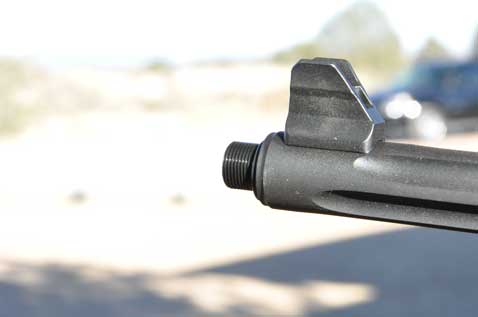 Frankly, I was surprised by the appearance of this new offering from Ruger. I had heard the company was working on a pistol caliber carbine so I expected to see an AR pattern carbine set up to handle pistol rounds – like everyone else is making. I should have known better because Ruger has a habit of doing things a bit differently than everyone else and this isn’t their first foray into pistol caliber carbines. From 1998-2006 Ruger made a carbine often referred to as the Ruger Police Carbine. Made in 9mm and 40S&W it bears some similarities to the PCC but was a far different design. The current PCC offers a number of improvements over the older model including an entirely different action – referred to as a dead blow action, a takedown feature similar to the 10-22 Takedown, stock spacers to adjust the length of pull from 12.5 to 14 inches and a 16.12” fluted, cold hammer forged, threaded barrel to promote accuracy and ease of cleaning and allow for the use of silencers and various muzzle devices. Other features include a reversible bolt handle and magazine release, a CNC milled receiver with an integral Picatinny rail, a durable, glass filled nylon synthetic stock with sling swivel studs and a forward mounted accessory rail for lights and lasers.
Frankly, I was surprised by the appearance of this new offering from Ruger. I had heard the company was working on a pistol caliber carbine so I expected to see an AR pattern carbine set up to handle pistol rounds – like everyone else is making. I should have known better because Ruger has a habit of doing things a bit differently than everyone else and this isn’t their first foray into pistol caliber carbines. From 1998-2006 Ruger made a carbine often referred to as the Ruger Police Carbine. Made in 9mm and 40S&W it bears some similarities to the PCC but was a far different design. The current PCC offers a number of improvements over the older model including an entirely different action – referred to as a dead blow action, a takedown feature similar to the 10-22 Takedown, stock spacers to adjust the length of pull from 12.5 to 14 inches and a 16.12” fluted, cold hammer forged, threaded barrel to promote accuracy and ease of cleaning and allow for the use of silencers and various muzzle devices. Other features include a reversible bolt handle and magazine release, a CNC milled receiver with an integral Picatinny rail, a durable, glass filled nylon synthetic stock with sling swivel studs and a forward mounted accessory rail for lights and lasers.
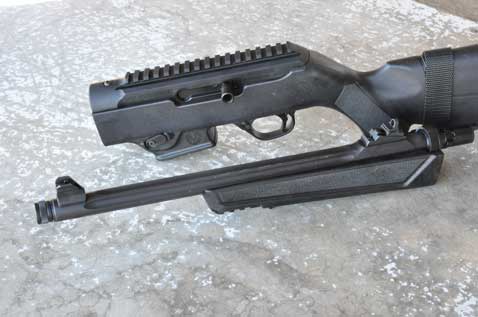 The carbine comes with a magazine well installed that will handle Ruger SR9 magazines, which are also the magazines used in Ruger’s new Security 9 pistol. At Gunsite we shot the carbine exclusively with these magazines and, as noted, they ran great. Possibly the coolest feature of the PCC is the Glock magazine well adapter you’ll find in the box with the rifle. Changing it out takes about 5 minutes and is easily done by following the instructions in the manual. This allows the use of Glock 9mm magazines from the 15 round G19 mag, to the 17 round G17 mag and the 33 round Glock magazine. The little Glock 26 magazines are too short to seat in the PCC. I have a bunch of Glock magazines on hand but have never bothered to obtain any of the 33 round magazines because, well, they’re kind of silly in any pistol but the full-auto Glock 18. However, as a carbine magazine they make a lot of sense so I ordered a couple of them from the good folks at Brownells.
The carbine comes with a magazine well installed that will handle Ruger SR9 magazines, which are also the magazines used in Ruger’s new Security 9 pistol. At Gunsite we shot the carbine exclusively with these magazines and, as noted, they ran great. Possibly the coolest feature of the PCC is the Glock magazine well adapter you’ll find in the box with the rifle. Changing it out takes about 5 minutes and is easily done by following the instructions in the manual. This allows the use of Glock 9mm magazines from the 15 round G19 mag, to the 17 round G17 mag and the 33 round Glock magazine. The little Glock 26 magazines are too short to seat in the PCC. I have a bunch of Glock magazines on hand but have never bothered to obtain any of the 33 round magazines because, well, they’re kind of silly in any pistol but the full-auto Glock 18. However, as a carbine magazine they make a lot of sense so I ordered a couple of them from the good folks at Brownells.
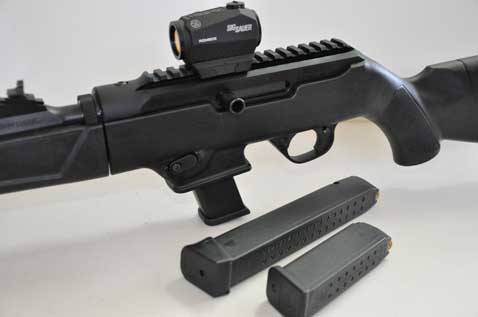 During my first range session with the PCC I fired every kind of 9mm practice and defensive ammunition I could scrounge up in the ammo locker. The PCC digested it all without drama and even rewarded me with a few groups under 2 inches at 25 yards using the ghost ring sights. This carbine is a soft shooter and as such is suitable for all shooters – kids, women and goateed operators. The trigger is based on the 10-22 trigger and breaks cleanly at about 4.5 pounds. Anyone familiar with the 10-22 cross-bolt safety and bolt hold open lever will feel right at home with the PCC. Because the bolt handle can be swapped from side to side I relocated it on the left, where I can do all my manipulation with my support hand while my strong hand controls the carbine.
During my first range session with the PCC I fired every kind of 9mm practice and defensive ammunition I could scrounge up in the ammo locker. The PCC digested it all without drama and even rewarded me with a few groups under 2 inches at 25 yards using the ghost ring sights. This carbine is a soft shooter and as such is suitable for all shooters – kids, women and goateed operators. The trigger is based on the 10-22 trigger and breaks cleanly at about 4.5 pounds. Anyone familiar with the 10-22 cross-bolt safety and bolt hold open lever will feel right at home with the PCC. Because the bolt handle can be swapped from side to side I relocated it on the left, where I can do all my manipulation with my support hand while my strong hand controls the carbine.
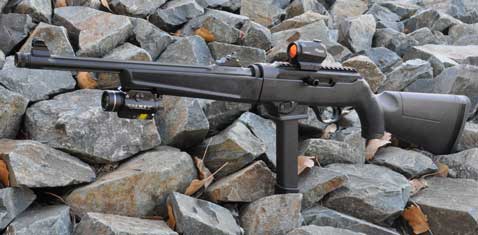 Considering the possible uses for the PCC I decided to dress it out as a defensive carbine for use in the home, motor home, boat, cabin, tent or personal vehicle. I first installed a Sig Romeo5 red dot sight atop the Picatinny rail. This little red dot has become one of my favorites because it is reasonably priced and has the circuitry to go to sleep when you leave it at rest and turn on instantly when you pick up or move the gun. Featuring long battery life this excellent sight operates on a single inexpensive CR 2032 battery. Next I added a Streamlight TLR-2 HL G weapon light to the front accessory rail. With a dazzling 800-lumen output and a green laser it can be operated as a light, a laser or a combination of the two. Also reasonably priced compared to some of the competition, I have come to rely on this excellent light/laser for my personal defensive house guns.
Considering the possible uses for the PCC I decided to dress it out as a defensive carbine for use in the home, motor home, boat, cabin, tent or personal vehicle. I first installed a Sig Romeo5 red dot sight atop the Picatinny rail. This little red dot has become one of my favorites because it is reasonably priced and has the circuitry to go to sleep when you leave it at rest and turn on instantly when you pick up or move the gun. Featuring long battery life this excellent sight operates on a single inexpensive CR 2032 battery. Next I added a Streamlight TLR-2 HL G weapon light to the front accessory rail. With a dazzling 800-lumen output and a green laser it can be operated as a light, a laser or a combination of the two. Also reasonably priced compared to some of the competition, I have come to rely on this excellent light/laser for my personal defensive house guns.
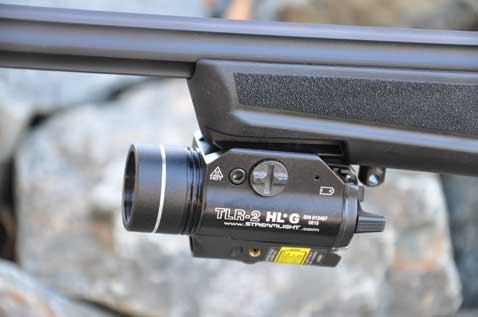 Now pay attention, this next part is tricky. When you place an optic on a rifle or carbine (or a pistol, for that matter) the center of the scope is above the center of the barrel. This creates a condition called offset, and depending upon how you sight the gun can mean that, at close ranges, your point of aim and point of impact will not coincide. In this case the center of the Romeo5 is almost exactly 1.5” above the barrel. After sighting the PCC in at 25 yards I went down to 3 yards and discovered my shot was exactly 1.5” below my point of aim. Why is this important? Because, as a house gun I anticipate having to shoot at close range and this offset will come into effect at indoors distances if I need to make a precision shot – like shooting a bad guy off my wife. Next, I sighted the green laser to be zeroed at indoor distances. When I look through the Romeo5 I see two dots; a red dot (dead center at 25 yards) with a green dot above it (dead center at across the room distances). And that’s why I like green lasers and red dots for house guns. This package is a bit hefty when you add over a pound of ammunition in the form of a 33 round magazine. All up, with the scope, light and 33 rounder the PCC weighs in at 7 pounds, 2 ounces, which is about normal for a loaded carbine.
Now pay attention, this next part is tricky. When you place an optic on a rifle or carbine (or a pistol, for that matter) the center of the scope is above the center of the barrel. This creates a condition called offset, and depending upon how you sight the gun can mean that, at close ranges, your point of aim and point of impact will not coincide. In this case the center of the Romeo5 is almost exactly 1.5” above the barrel. After sighting the PCC in at 25 yards I went down to 3 yards and discovered my shot was exactly 1.5” below my point of aim. Why is this important? Because, as a house gun I anticipate having to shoot at close range and this offset will come into effect at indoors distances if I need to make a precision shot – like shooting a bad guy off my wife. Next, I sighted the green laser to be zeroed at indoor distances. When I look through the Romeo5 I see two dots; a red dot (dead center at 25 yards) with a green dot above it (dead center at across the room distances). And that’s why I like green lasers and red dots for house guns. This package is a bit hefty when you add over a pound of ammunition in the form of a 33 round magazine. All up, with the scope, light and 33 rounder the PCC weighs in at 7 pounds, 2 ounces, which is about normal for a loaded carbine.
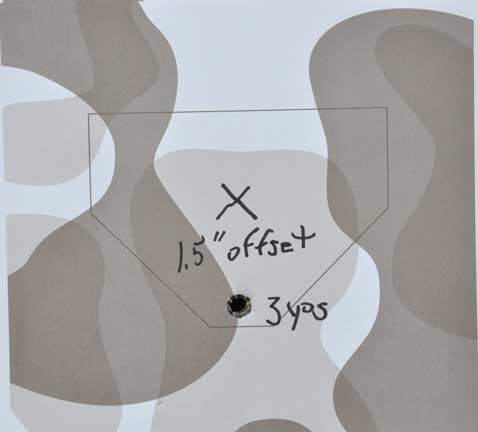 So why might you need a PCC? To me it makes sense as a trainer, a plinker or a house or car gun, the takedown feature being particularly attractive. You can break it down, stuff it in a small backpack and carry or transport it discretely. When I chronographed several defensive loads I discovered they were gaining between 200 and 250 feet per second velocity out of the PCC barrel. For example, Sig’s excellent Elite Performance 115 grain hollowpoint is listed at a velocity of 1185 feet per second and I found it averages 1463 feet per second in the PCC. That’s moving the 9mm round up into .38 Super territory and giving you a lot more “power” without adding blast or recoil. I also found that accuracy at 25 yards was outstanding when using the red dot and shooting defensive ammunition with everything I tried averaging just a bit over one inch.
So why might you need a PCC? To me it makes sense as a trainer, a plinker or a house or car gun, the takedown feature being particularly attractive. You can break it down, stuff it in a small backpack and carry or transport it discretely. When I chronographed several defensive loads I discovered they were gaining between 200 and 250 feet per second velocity out of the PCC barrel. For example, Sig’s excellent Elite Performance 115 grain hollowpoint is listed at a velocity of 1185 feet per second and I found it averages 1463 feet per second in the PCC. That’s moving the 9mm round up into .38 Super territory and giving you a lot more “power” without adding blast or recoil. I also found that accuracy at 25 yards was outstanding when using the red dot and shooting defensive ammunition with everything I tried averaging just a bit over one inch.
I can’t find any fault with the PCC. It’s accurate, reliable, versatile and made in the USA in Newport, New Hampshire. With a list price of $649 and a street price considerably lower it represents a solid value, and that’s what Ruger is all about.
For more information:
About the Author:
 Ed Head is a regular on Shooting Gallery, Gun Stories and Down Range TV. He has worked for almost 30 years in law enforcement, first in the United States Air Force and then with the United States Border Patrol, retiring as a Field Operations Supervisor. During his Border Patrol career, Ed worked in a variety of patrol, investigative and training capacities. Ed has an extensive background as a firearms instructor, having trained thousands, ranging from beginners to police, military and special operations personnel. Having taught at Gunsite for 20 years, Ed first trained there under the world famous shooting school’s founder, Jeff Cooper, then later ran the school as the operations manager for more than five years. Ed lives in Chino Valley, Arizona, where he continues to teach and write.
Ed Head is a regular on Shooting Gallery, Gun Stories and Down Range TV. He has worked for almost 30 years in law enforcement, first in the United States Air Force and then with the United States Border Patrol, retiring as a Field Operations Supervisor. During his Border Patrol career, Ed worked in a variety of patrol, investigative and training capacities. Ed has an extensive background as a firearms instructor, having trained thousands, ranging from beginners to police, military and special operations personnel. Having taught at Gunsite for 20 years, Ed first trained there under the world famous shooting school’s founder, Jeff Cooper, then later ran the school as the operations manager for more than five years. Ed lives in Chino Valley, Arizona, where he continues to teach and write.



 MidwayUSA
MidwayUSA Ruger Firearms
Ruger Firearms SCCY Firearms
SCCY Firearms Streamlight
Streamlight Action Targets
Action Targets Gunsite Academy
Gunsite Academy
You must be logged in to post a comment Login